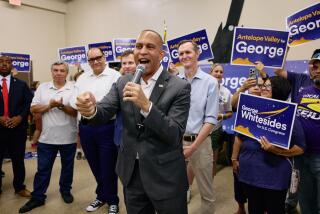Delegates Can See Global Economy at Work Right Here in L.A. Region
Will the issues debated by the Democrats this week--and the Republicans two weeks ago--have any particular effect on the economy of Southern California?
They could, but only in a distant, indirect way. Most policy discussions at conventions seem removed from the realities of this region’s global economy.
So Southern California will keep working at its furious pace while delegates in Staples Center talk about jobs and taxes, trade and investment. If the delegates and visitors toured the region they would learn more about economic realities than they will indoors.
A look at some of the activities they might see can give us locals an up-to-date picture of our changing world, too.
Both Republicans and Democrats this year are stressing programs to help the working poor. Republican candidate George W. Bush would help through tax credits for health insurance and education. Democratic candidate Al Gore would get seed capital to inner-city entrepreneurs so they could set up their own businesses.
Those are good ideas, and Gore is thinking correctly when he focuses on minority entrepreneurship.
Southern California has a lot of working poor, perhaps 800,000 workers making $7 an hour--$14,500 a year--in garment factories, retail stores and restaurants and by working as cleaners and janitors.
But in this bubbling economy, where unemployment is down to 5.2% in Los Angeles and 2.8% in Orange County, many workers could do better if they had training in modern equipment. That’s why a mile or so from Staples Center, on Figueroa Street near Martin Luther King Jr. Boulevard, convention delegates could see an answer to a problem at the Community Financial Resources Center.
The CFRC is an economic development organization backed by the city of Los Angeles and local banks and businesses. And it has just opened a computer access lab--officially called the Business Innovation and Technology Center--where people can work on and learn computers.
And that’s a great idea. A worker familiar with computers and laser scanners and GPS locaters can earn more than $18 an hour--$36,000 a year--in Southern California’s many warehouses that serve the region’s massive foreign trade activity.
Skilled workers are in short supply. Truck drivers can earn $50,000 a year, says Jorge Rodriguez, chief financial officer of Mercado Latino, a family firm in Industry that distributes Latin American food specialties in the Western states.
The company was founded 33 years ago by Graciliano Rodriguez, an immigrant from Cuba who distributed Central and South American vegetables as a sideline to his full-time job. Now Mercado receives vegetable cargoes through the port of Long Beach and sends more than 150 trucks on routes from Washington state to Texas.
The political parties both support foreign trade, although Democrats are more ambivalent about it because of labor union opposition.
But foreign trade is a growing U.S. reality and a mainstay of Southern California, which has the largest seaport and air cargo facilities in the country. Delegates and visitors might appreciate the speed and complexity of trade today if they visited the San Gabriel Valley, which has become a hub for the world’s computer parts.
They could visit Roy Han, co-owner of MTC Worldwide Corp., a 10-year-old Industry firm that distributes computer hard drives to Asia and around the United States. The manufacture of hard drives, which store computer data, is a tough, capital- and technology-intensive business that only a handful of firms compete in--IBM, Seagate, Western Digital, Maxtor, Fujitsu, Toshiba.
Those who buy drives from the manufacturers for resale to the world’s computer makers must be nimble because prices fluctuate hourly. Roy Han, who emigrated from Taiwan in 1982 to take engineering degrees from Washington University in St. Louis and the University of Houston, and his brother Jeff, who runs an office in Taipei, have built a $300-million-a-year business by being nimble.
“If we see a manufacturer selling overproduction at a good price, we buy a lot and hold in inventory,” Roy Han explains. “We have the financial strength”--and a $20-million credit line from Imperial Bank, a mid-size Los Angeles bank started 37 years ago by George Graziadio, a shopping center developer.
Still, global business is not all success and romance. Southern California’s garment industry, which employs more than 100,000 workers, is today partly a respected fashion business and partly a low-wage production activity that exists because women’s apparel houses can’t wait months for shipments from abroad. “We get to make women’s apparel here because styles and markets change so quickly,” explains Joe Rodriguez, head of the Garment Contractors of Southern California Assn.
“It’s a tough business, with wages of $7 an hour for sewing machine operators and few benefits,” Rodriguez says. “We used to make men’s clothing with longer runs, but that business has all gone to Mexico, Honduras and China.
“And now the African and Caribbean Initiative will take business from those countries,” Rodriguez says, referring to a trade bill passed this year in Congress. “Still, our industry survives.”
So what should the delegates and political candidates do to help the industry? Repeal the Africa-Caribbean Initiative? Prevent Mexico and Honduras from manufacturing clothing? As if they could!
No, Gore and Bush are already thinking of the wiser course: access to capital for entrepreneurs; investment in technology to help the fashion industry; education and computer training for the garment workers so they can get the higher-paying jobs crying out for applicants.
It’s good the delegates came to Los Angeles. Nowhere else could they see so much of the global economy than from their hotel windows.
Recent columns by James Flanigan are available at http://arstechnica.netblogpro.com/flanigan.
More to Read
Get the L.A. Times Politics newsletter
Deeply reported insights into legislation, politics and policy from Sacramento, Washington and beyond. In your inbox three times per week.
You may occasionally receive promotional content from the Los Angeles Times.










